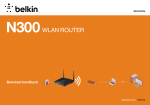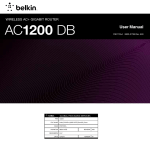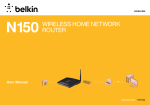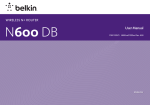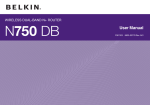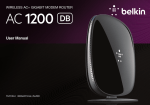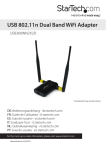Download Belkin N300
Transcript
English N300 User Manual WIRELESS home network Router or 8820ed00831uk F9K1010 Table Of Contents What’s in the Box . . . . . . . . . . . . . . . . . . . . . . . . . . . . . . . . . . . . . . . . . . . . . 3 Initial Setup . . . . . . . . . . . . . . . . . . . . . . . . . . . . . . . . . . . . . . . . . . . . . . . . . . 3 How to Set It UP . . . . . . . . . . . . . . . . . . . . . . . . . . . . . . . . . . . . . . . . . . . . . . 4 Adding Computers to Your Network . . . . . . . . . . . . . . . . . . . . . . . . . . . . . . 5 Manually Set Up Your Internet Connection . . . . . . . . . . . . . . . . . . . . . . . . 6 Front Panel . . . . . . . . . . . . . . . . . . . . . . . . . . . . . . . . . . . . . . . . . . . . . . . . . . 12 Back Panel . . . . . . . . . . . . . . . . . . . . . . . . . . . . . . . . . . . . . . . . . . . . . . . . . . 13 Technical Details . . . . . . . . . . . . . . . . . . . . . . . . . . . . . . . . . . . . . . . . . 14 Technical Features . . . . . . . . . . . . . . . . . . . . . . . . . . . . . . . . . . . . . . . . . . . 14 System Requirements . . . . . . . . . . . . . . . . . . . . . . . . . . . . . . . . . . . . . . . . 15 USING YOUR ROUTER . . . . . . . . . . . . . . . . . . . . . . . . . . . . . . . . . . . . 16 Using the LAN IP Setup . . . . . . . . . . . . . . . . . . . . . . . . . . . . . . . . . . . . . . . Configuring Your Internet Connection . . . . . . . . . . . . . . . . . . . . . . . . . . . Cloning your MAC address . . . . . . . . . . . . . . . . . . . . . . . . . . . . . . . . . . . . Enabling Website Filtering . . . . . . . . . . . . . . . . . . . . . . . . . . . . . . . . . . . . . Configuring Basic Wireless Settings . . . . . . . . . . . . . . . . . . . . . . . . . . . . Restarting Your Router . . . . . . . . . . . . . . . . . . . . . . . . . . . . . . . . . . . . . . . . Restoring Your Router to Factory Defaults . . . . . . . . . . . . . . . . . . . . . . . Backing Up Your Configuration . . . . . . . . . . . . . . . . . . . . . . . . . . . . . . . . . Restoring Previous Settings . . . . . . . . . . . . . . . . . . . . . . . . . . . . . . . . . . . Enabling Auto Firmware Update for Your Router . . . . . . . . . . . . . . . . . . Updating the Router’s Firmware . . . . . . . . . . . . . . . . . . . . . . . . . . . . . . . . Configuring Administrator Password . . . . . . . . . . . . . . . . . . . . . . . . . . . . Configuring Time Zone . . . . . . . . . . . . . . . . . . . . . . . . . . . . . . . . . . . . . . . . Configuring Remote Management . . . . . . . . . . . . . . . . . . . . . . . . . . . . . . Configuring UPnP . . . . . . . . . . . . . . . . . . . . . . . . . . . . . . . . . . . . . . . . . . . . Configuring the Eco Mode . . . . . . . . . . . . . . . . . . . . . . . . . . . . . . . . . . . . . Configuring Self Healing . . . . . . . . . . . . . . . . . . . . . . . . . . . . . . . . . . . . . . 16 18 24 25 25 27 28 29 31 33 34 37 38 39 40 40 41 Troubleshooting, Support, and Warranty . . . . . . . . . . . . . . . . . . . . 42 Troubleshooting . . . . . . . . . . . . . . . . . . . . . . . . . . . . . . . . . . . . . . . . . . . . . Belkin International, Inc., Limited 2-Year Product Warranty . . . . . . . . . European Compliance Statement: . . . . . . . . . . . . . . . . . . . . . . . . . . . . . . General Safety Information: . . . . . . . . . . . . . . . . . . . . . . . . . . . . . . . . . . . . 42 47 49 49 GETTING STARTED What’s in the Box Initial Setup N300 Wireless Router Where to Place Your Router Ethernet cable For the best results, place the Router next to your modem in an open location away from large metal objects and magnets such as those found in speakers. Raising the Router above floor level can improve the strength of your wireless signal. Power supply Belkin CD with User Manual Quick Installation Guide Service Card 3 GETTING STARTED 3. Power up your modem by plugging in its power supply. How to Set It UP 4. Power up your Router by plugging in its power supply. Connect Your N300 Router 1. Turn off your modem by disconnecting its power supply. 2. Connect your Router to your modem using the cable. 4 GETTING STARTED Adding Computers to Your Network When requested, please enter the password Wireless devices such as computers, network printers, and gaming systems can connect to your Router with a few simple steps. (security key) provided on the card. Using the WPS Button Manual Setup Start WPS Push Button Connection (WPS PBC) on your computer or other Wi-Fi device that you would like to connect wirelessly to your Router. Often there will be a button for this purpose in software that came with the device, or a physical “WPS” button on the device itself. If you know what sort of Internet service you have, you might try a manual setup. For this you will need a Wi-Fi-enabled smartphone, tablet, or computer. Within two minutes, press the WPS button on your Router. Wirelessly Connect to Your Router The WPS indicator will blink green while it listens for your Wi-Fi device. Once a connection is established, the light will turn green for about 5 minutes and then go out. If a connection is not established, the light will blink green for 30s. You may repeat the process to try again. The default network name and password are printed on the foot of the Router. Use your computer, tablet, or smartphone to connect to the wireless network shown on the network ID card. You can repeat this process for each WPS-enabled device you’d like to add to your network. 5 GETTING STARTED Manually Set Up Your Internet Connection You can also try visiting http://192.168.2.1/. Use a browser to visit http://Router/. The Router homepage should appear. The status of your Internet connection is shown in the upper right corner of the Router homepage. If after a few moments it says “Connected”, you’re done! You can surf the Internet. 6 GETTING STARTED If not, select “Connection Type” from the menu on the left. 7 GETTING STARTED If a password screen appears, press “Submit”. Dynamic Connection Cable and fiber customers generally require a dynamic connection. Some DSL customers require a PPPoE connection. Let’s try dynamic first. Select “Dynamic” from the menu that appears and press “Next”. 8 GETTING STARTED Enter the host name provided by your Internet service provider. Click “Apply Changes”. If after a few minutes your Internet Status says “Connected”, you’re done! You can surf the Internet. If these steps do not work, try restarting your modem and repeating the process. If not, we’ll try a PPPoE connection next. 9 GETTING STARTED PPPoE Connection Enter the username and password supplied by your Internet provider and click “Apply Changes”. Ignore the other fields. Some DSL customers require a PPPoE connection. \If after a few minutes your Internet Status says “Connected”, you’re done! You can surf the Internet. Select PPPoE this time and press “Next”. If these steps do not work, try restarting your modem and repeating the process. 10 GETTING STARTED Connecting Additional Devices Windows® 7 iOS Your computer provides a menu of available wireless networks at the right end of the task bar. (iphone, iPad, and iPod touch) Right-click on the icon that looks like signal strength bars. Open the “Settings” app and select the “Wi-Fi” menu item. Select your wireless network from the list. If asked, enter your network password (network key). Select your wireless network from the list that appears there. If asked to do so, enter the network password. Mac OS® X Windows Vista® and Windows XP Your Mac® provides a menu of available wireless networks at the right end of the menu bar. Your device provides a menu of available wireless networks at the right end of the task bar. Click on the icon showing wireless waves. Right-click on the icon that shows a computer with wireless waves (XP) or two computers (Windows Vista) . Select your wireless network from the list that appears there. If asked to do so, enter the network password. Choose “View Available Wireless Networks” (XP) or “Connect to a network” (Vista) from the menu. Android (phones and tablets) Select your wireless network from the list. If asked, enter your network password (network key). Open the “Settings” app and select “Wireless” and “Network”. From there, select “Wi-Fi” to see the list of available networks. Select your wireless network from the list. If asked to do so, enter your network password. 11 GETTING TO KNOW YOUR ROUTER Front Panel 5 minutes and then goes out when the Router has made a secure connection with the computer or other device. Failed Connection: The WPS light is BLINKING GREEN for 30s after the WPS connection fails. Your Router’s status is shown by the lights on the front panel. WAN Light Power Light Off: WAN connection is not created. Off: The Router is not plugged into a power source. Blinking Green: Data is being transmitted on the WAN port. Solid Green: Power is supplied to the Router. Solid Green: The Router is connected to the Internet. WLAN Light LAN Light Off: WLAN is disabled. Off: LAN connection is not created. Blinking Green: Wireless data is being transmitted in the WLAN. Blinking Green: Data is being transmitted on the LAN port. Solid Green: WLAN is enabled but no data transfer. Solid Green: The Router is connected to devices through Ethernet cables. Wi-Fi Protected Setup (WPS) Light Off: Idle Blinking Green: The Router is listening for a WPSenabled computer or other device. Successful Connection: The WPS light is SOLID GREEN for 12 GETTING TO KNOW YOUR ROUTER Back Panel WPS Button The WPS button on the back of your Router can be used to help establish a secure connection between your Router and other WPSenabled Wi-Fi devices such as computers. To use the WPS feature on your Router, see “Getting Started > Adding Computers to Your Network > Using the WPS Button”. Reset Button This button is used to restore the factory default settings. To reset the Router, press and hold this button for 8-10 seconds. Power Connector Connect the included power supply to this jack. Modem (WAN) Connector Connect your modem to this port using an Ethernet cable. Wired (LAN) Connectors Connect computers and other wired network device to these ports using Ethernet cables. 13 Technical Details Technical Features Universal Plug-and-Play (UPnP) Compatibility The UPnP (Universal Plug-and-Play) feature in your Router offers seamless operation of voice and video messaging, games, and other applications that are UPnP-compliant. Integrated 802.11n Wireless Access Point Utilizing MIMO (Multiple Input Multiple Output) smartantenna technology, your Router can reach data transfer speeds of up to 300Mbps across your network. Web-Based Advanced User Interface You can easily make changes to your Router’s advanced settings through your web browser. These changes can be made from any computer on your network. NAT IP Address Sharing To save you the cost of adding IP addresses per computer in your house, your Belkin Router uses Network Address Translation (NAT) technology, allowing you to share a single IP address across your network. Integrated 4-Port 10/100 Switch Your Router has a built-in, 4-port network switch to allow your wired computers to share: printers, data, MP3 files, digital photos, and much more. SPI Firewall Your Router is equipped with a firewall that will protect your network from a wide array of common attacks and viruses. 14 Technical Details System Requirements Router Broadband Internet connection such as a cable or DSL modem with RJ45 (Ethernet) connection At least one computer with an installed network interface adapter TCP/IP networking protocol installed on each computer RJ45 Ethernet networking cable Internet browser 15 USING YOUR ROUTER Using the LAN IP Setup Setup steps: The “LAN Settings” page allows changing the Router’s LAN IP address as required and configuring Dynamic Host Configuration Protocol (DHCP). Open a Web browser on the computer. In the address bar of the Web browser, type http://192.168.2.1. Configuring Parameters of LAN IP Setup LAN IP setup parameters are advanced settings that you may require if you are a network administrator or your network requires a different IP addressing scheme. The Router is shipped with the default IP address on the LAN side and with the DHCP server enabled. Click “Login” in the upper right corner of the page. The Router does not ship with a password, so just click “Submit”. Note: If you change the default LAN IP address, you must use the new LAN IP address to log in. Click on “LAN Settings” in the left column under the “LAN Setup” heading. 16 USING YOUR ROUTER Configure the IP address and subnet mask. Click “Login” in the upper right corner of the page. The Router does not ship with a password, so just click “Submit”. IP Address: The IP address that a LAN user uses to access the Router. The default IP is 192.168.2.1. IP Subnet Mask: Subnet mask of the LAN port. You can enter a different subnet mask according to the actual network status. Click “Apply”. Click on “LAN Settings” in the left column under the “LAN Setup” heading. Using the Router as a DHCP Server By default, the Router acts as a DHCP server, automatically assigning IP addresses to comupters in the LAN. Users do not need to configure TCP/IP protocol paramters such as the IP address, the subnet mask, the gateway, and the DNS server information for computers connected to the Router’s LAN. Setup steps: Open a Web browser on the computer. Select the “On” button to use the Router as a DHCP server. In the address bar of the Web browser, type http://192.168.2.1. Configure the parameters below. IP Pool Starting Address/IP Pool Ending Address: Set the starting and ending IP addresses to specify a pool of IP addresses to be assigned by the DHCP server. After you set “Starting IP Address/ Ending IP Address”, hosts in the LAN obtain IP addresses that are in the range of the starting and ending IP addresses. 17 USING YOUR ROUTER Lease Time: The valid time for an IP address that is automatically assigned to a device by the DHCP server to a host. The DHCP server does not assign the IP address to other hosts within the specified time. If selecting “Forever”, you save devices in the LAN with fixed addresses. Setup steps: Click “Connection Type” in the left column under the “Internet WAN” heading. Configuring the Local Domain Name The local domain name is a user-friendly name for your Router. At the bottom of the “LAN Settings” page, you can set a local domain name. The default name is Belkin. There is no need to change this setting unless required. Configuring Your Internet Connection Settings related to your Internet service are specified in the “Connection Type” page under the “Internet WAN” heading. Select a WAN connection type. Contact your ISP if you do not know your WAN connection mode. Dynamic Connection Cable and fiber customers generally require a dynamic connection. 18 USING YOUR ROUTER Select “Dynamic” in the “Connection Type” page that appears. Click “Next”. Enter the host name provided by your Internet provider. Click “Apply Changes”. 19 USING YOUR ROUTER If after a few minutes your Internet Status says “Connected”, you’re done! You can surf the Internet. Configure the parameters below. These parameters cannot be left blank. Static Connection IP Address: Enter the WAN IP address provided by the ISP. The parameter must be entered. Select Static IP if your ISP provides the IP address, subnet mask, and information about the gateway and DNS server. Subnet Mask: Enter the WAN subnet mask provided by the ISP. It varies with the network type. It is usually 255.255.255.0 (Class C). Setup steps: ISP Gateway Address: Enter the IP address of the gateway provided by the ISP. It is the IP address used for connecting to the ISP. Click “Connection Type” in the left column under the “Internet WAN” heading. Select “Static” in the “Connection Type” page that appears. 20 USING YOUR ROUTER Click “Click here to enter your DNS Settings” to configure DNS information. Clear the “Automatic from ISP” check box. In the “DNS Address” and “Secondary DNS Address” fields, enter the IP addresses of the primary DNS server and the secondary server (if available). At least enter one DNS server IP address. Click “Apply Changes”. If after a few minutes your Internet Status says “Connected”, you’re done! You can surf the Internet. PPPoE Connection Most DSL providers use PPPoE (Point-to-Point Protocol over Ethernet) as the connection type. If you use a DSL modem to connect to the Internet, your ISP may use PPPoE to log you into the service. Setup steps: Click “Connection Type” in the left column under the “Internet WAN” heading. Select “PPPoE” in the “Connection Type” page that appears. 21 USING YOUR ROUTER Configure the parameters below. PPTP/L2TP Connection User Name and Password: Enter the user name and password provided by the ISP. The user name and password are used to log in to the ISP server. Some ISPs require a connection using the PPTP or L2TP protocol. Enter the account and password provided by your ISP. The following takes PPTP connection as an example. Retype Password: Enter the password again. Service Name: If several PPPoE servers are available, specify which server to use. Setup steps: Click “Connection Type” in the left column under the “Internet WAN” heading. IP assigned by ISP: You can select either to an IP address assigned by your ISP, or to manually set an IP address in the “IP Address” field. Select “PPTP” in the “Connection Type” page that appears. MTU: The maximum transmission unit. We strongly recommend you to use the default setting unless your ISP gives you a specific MTU setting. If you select the “Disconnect after xxx minutes of no activity” check box and specify a time interval, the system interrupts the Internet connection when there is no Internet access behavior within the specified time. Click “Apply Changes”. If after a few minutes your Internet Status says “Connected”, you’re done! You can surf the Internet. 22 USING YOUR ROUTER Configure the parameters below. If you select the “Disconnect after xxx minutes of no activity” check box and specify a time interval, the system interrupts the Internet connection when there is no Internet access behavior within the specified time. PPTP Account and PPTP Password: Enter the PPTP account and password provided by the ISP. The PPTP account and password are used to log in to the ISP server. Retype Password: Enter the password again. Host Name: (Optional) Enter the host name. Service Address: Enter the IP address of the ISP server. IP Address Assignment: You can select either to dynamically get an IP address from the ISP or to use a static IP address. If you select “Use Static IP Address”, manually enter the IP address, the subnet mask, and the default gateway. 23 USING YOUR ROUTER Click “Click here to enter your DNS Settings” to configure DNS information. address will not cause any problems with your network. To Clone your MAC address, make sure that you are using the computer which was ORIGINALLY CONNECTED to your modem before the Router was installed. Click the “Clone” button and click “Apply Changes”. Your MAC address is now cloned to the Router. Either select or clear the “Automatic from ISP” check box. If you clear the check box, in the “DNS Address and Secondary DNS Address” fields enter the IP addresses of the primary DNS server and the secondary server (if available). At least enter one DNS server IP address. Click “Apply Changes”. If after a few minutes your Internet Status says “Connected”, you’re done! You can surf the Internet. Telstra Bigpond/OptusNet Cable Use this option for Bigpond Cable and OptusNet Cable connections only. Cloning your MAC address Belkin provides the ability to clone (copy) the MAC address of the computer into the Router. This MAC address, in turn, will be seen by the ISP's system as the original MAC address and will allow the connection to work. If you are not sure if your ISP needs to see the original MAC address, simply clone the MAC address of the computer that was originally connected to the modem. Cloning the 24 USING YOUR ROUTER Configuring Basic Wireless Settings Enabling Website Filtering You can view and specify the wireless security settings of your Router. The Router allows you to restrict website access to guard you from unsafe and inappropriate websites on any devices on your network. Setup steps: Open a Web browser on the computer. In the address bar of the Web browser, type http://192.168.2.1. Click “Login” in the upper right corner of the page. The Router does not ship with a password, so just click “Submit”. 25 USING YOUR ROUTER Click on “Channel and SSID” in the left column under the “Wireless” heading. The default channel is Auto. It is unnecessary to change the wireless channel unless you notice interference problems with another nearby wireless Router or access point. Select a channel that is not being used by any other nearby wireless networks. Configure the following parameters. SSID: Set the wireless network name. The SSID can contain up to 32 alphanumeric characters. The default SSID is “belkin.###”. The default mode is 802.11b/g/n. Broadcast SSID: If checked, the Router broadcasts its SSID in the wireless network, so that wireless clients can scan the SSID and access the wireless network under the SSID. The check box is selected by default. If the check box is cleared, only devices that know the correct SSID can connect to the Router. If you do not know which mode to use, select 802.11b/g/n. The default bandwidth is 20/40MHz. The default protected mode is Off. For the remaining settings, use the defaults. In most situations, best performance is achieved with Protected Mode Off. If you are operating in an environment with HEAVY 802.11b traffic or interference, best performance may be achieved with Protected Mode On. The default 802.11e/WMM QoS mode is On. QoS prioritizes important data on your network such as multimedia content and voice-over-IP (VoIP) so it will not be interfered by other data being sent over the network. Click “Apply Changes”. 26 USING YOUR ROUTER Restarting Your Router Sometimes, in order to make some changes take effect, you need to restart the Router. Click on “Restart Router” in the left-hand column under the “Utilities” heading. Setup Steps Click on the “Restart Router” button toward the middle of screen. A dialog box appears to ask you whether to restart the Router. Click the “OK” button to restart the Router. After clicking the “OK” button, the Router begins to restart. 27 USING YOUR ROUTER Restoring Your Router to Factory Defaults Setup Steps Resetting the Router will restore the Router’s normal operation while maintaining the programmed settings. Reset the Router in rare cases when the Router may function improperly. Click on “Restore Factory Defaults” in the lefthand column under the “Utilities” heading. Using the Reset Button Use the restore option in instances where you may have forgotten your custom password or when the Router may function improperly. Push and hold the “Reset” button for 8-10 seconds, and then release it. The LAN light on the Router will momentarily flash and the WLAN light will turn out. When the LAN and WLAN lights become solid green again, the reset is complete. Restoring the Router to Default Settings Using the Web Interface You can also restore the factory defaults using the web interface. This may be because the Router is not performing as expected or you wish to remove all previously configured settings. 28 USING YOUR ROUTER Backing Up Your Configuration Click on the “Restore Defaults” button. The configuration settings of the Router are stored within the Router in a configuration file. You can back up (save) the file and retrieve it for later use. A warning box will open that says, “Warning: All your settings will be lost. Are you sure you want to do this?” Click “OK”. We recommend that you back up your configuration file after you complete settings. If the Router fails or becomes corrupted, or an administrator password is lost, you can easily re-obtain your configuration by restoring the configuration file. The Router will begin the restoration process. Once the restoration process is complete, the Router will reboot. Note: This may take several minutes. Your Router has been successfully restored to its factory settings. Setup Steps 29 USING YOUR ROUTER Click on “Save/Backup Settings” in the left-hand column under the “Utilities” heading. A dialog box will open that says, “Do you want to open or save this file?” Click “Save”. Click on the “Save” button. 30 USING YOUR ROUTER Restoring Previous Settings Select the location for saving the configuration file. Enter the file name and select the file type, then click the “Save “button. Sometimes, you need to restore the previous settings. This may be because the Router is not performing as expected or you wish to remove all current settings. When the download process is complete, click “Close”. Your Router’s configurations have been successfully saved to your local PC. Setup Steps 31 USING YOUR ROUTER Click on “Restore Previous Settings” in the lefthand column under the “Utilities” heading. Select the configuration file by left-clicking on it and then click the “Open” button in the lower-right corner of the window. This will take you back into the Router’s interface. Click the “Browse…” button toward the middle of the screen to search for the file you saved previously. Click the “Restore” button. Note: The version of configuration file in the images below is depicted as an example. Your file name will vary depending on your model and version. 32 USING YOUR ROUTER Click on “System Settings” in the left-hand column under the “Utilities” heading. A prompt asking, “Do you want to continue and restore settings?” will appear. Click “OK” and then the Router begins to restore the previous settings. Toward the lower-half side of the screen you will find “Auto Update Firmware Enabling”. The previous settings have been restored successfully. Select the “Enable” radio button. Enabling Auto Firmware Update for Your Router Click “Apply Changes”. The Router has the capability to automatically check for a newer version of firmware and alert you when it’s available. You can choose to download the new version or ignore it. By default this feature is enabled. Note: We recommend you use a computer that has a wired connection to the Router. Setup Steps: 33 USING YOUR ROUTER Updating the Router’s Firmware Click on “Firmware Update” in the left-hand column under the “Utilities” heading. The following steps show you how to update your Router’s firmware using its Web interface. Click “Check Firmware” to check for new firmware versions. If a new version is found, you can directly update your firmware by following the prompts. Checking for New Firmware in the Firmware Upgrade Screen N150 Router allows you to check for a new firmware update available for this Router. Setup steps: 34 USING YOUR ROUTER Click on “Firmware Update” in the left-hand column under the “Utilities” heading. Updating Manually to New Router Firmware You can also manually update your Router firmware. Setup Steps Locate and download the firmware file from the Belkin support site. (Type your part number into the search box in the top right corner and look for “Firmware” in the title.) Save the file to a location on your computer where you can get to it easily, such as your desktop. Connect the computer to one of the four LAN ports on the Router. Open a web browser on the computer. In the address bar of the web browser, type “http://192.168.2.1” and press “Enter” on your keyboard. Click “Login” in the upper right-hand corner of the page. The Router does not ship with a password, so just click “Submit”. 35 USING YOUR ROUTER Click the “Browse…” button toward the middle of the screen to search for the file you saved previously. Select the firmware file (an “.img” file) by left-clicking on it and then click the “Open” button in the lower-right corner of the window. This will take you back into the Router’s interface. Note: The firmware version in the images below is depicted as an example. Your file name will vary depending on your model and version. Click the “Update” button Congratulations. The firmware has been updated successfully. 36 USING YOUR ROUTER Configuring Administrator Password Click on “System Settings” in the left-hand column under the “Utilities” heading. The Router ships with NO password entered. If you wish to add a password for more security, you can set a password here. Keep your password in a safe place, as you will need this password if you need to log into the Router in the future. It is also recommended that you set a password if you plan to use the remote management feature of this Router. Configuring the administrator password and login timeout. Click “Apply Changes”. Setup Steps: 37 USING YOUR ROUTER Configuring Time Zone Click on “System Settings” in the left-hand column under the “Utilities” heading. The Router keeps time by connecting to a Simple Network Time Protocol (SNTP) server. This allows the Router to synchronize the system clock to the global Internet. The synchronized clock in the Router is used to record the security log and control client filtering. Select the time zone that you reside in and the NTP server. If you reside in an area that observes Daylight Saving, then place a checkmark in the box next to “Daylight Savings”. Select the time zone that you reside in. The system clock may not update immediately. Click “Apply Changes”. Setup Steps: 38 USING YOUR ROUTER Configuring Remote Management Click on “System Settings” in the left-hand column under the “Utilities” heading. Remote management allows you to make changes to your Router's settings from anywhere on the Internet. Before you enable this function, make sure you have set the administrator password. If you select the “Any IP address can remotely manage the router” check box, you are allowed to access the Router from anywhere on the Internet by typing in your WAN IP address from any computer on the Internet. Setup Steps: If you do not select the “Any IP address can remotely manage the router” check box, specify an IP address to remotely manage the Router. Note: Selecting “Only this IP address can remotely manage the router” is more secure, but less convenient. In the “Remote Access Port” field, set the port number for accessing the router through remote Web management. Click “Apply Changes”. 39 USING YOUR ROUTER Configuring the Eco Mode Configuring UPnP This function allows you to dim the LEDs on the front of the Router to save power and disable the wireless radio at predetermined times. UPnP (Universal Plug-and-Play) offers seamless operation of voice messaging, video messaging, games, and other applications that are UPnP compliant. Setup Steps: The Router ships with the UPnP feature enabled. If you are using any applications that are UPnP compliant and wish to take advantage of the UPnP features, you can enable the UPnP feature. Click on “System Settings” in the left-hand column under the “Utilities” heading. 40 USING YOUR ROUTER Select the “Disable radio from” to enable the Eco mode. Click on “Self Healing” in the left-hand column under the “Utilities” heading. Specify the days you want to use the Eco mode. Select the “Enabled” radio button to enable automatically initialization for your Router. Click “Apply Changes”. Specify the days and the time for automatically initialization. Configuring Self Healing Click “Apply Changes”. The self healing function allows the Router to implement regular restart, reducing equipment function failure. You can arrange a schedule for Router’s auto initialization. Setup Steps: 41 Troubleshooting, Support, and Warranty Troubleshooting I can’t connect to the Internet wirelessly. If the light on the front of the Router is solid green, then your Router is connected to the Internet. You may not be connected to the Router’s wireless network. Please refer to “Adding Computers to Your Network” in this manual for instructions. 42 Troubleshooting, Support, and Warranty I can’t connect to the Internet wirelessly and my network name is not listed in Available Networks. My wireless network per formance is slow, inconsistent, suffers from weak signal, or I’m having difficulty maintaining a VPN connection. 1.Verify that your Router is on and the front-panel light shows solid green. Wireless technology is radio-based, which means connectivity and the throughput performance between devices decreases when the distance between devices increases. Other factors that will cause signal degradation (metal is generally the worst culprit) are obstructions such as walls and metal appliances. Note also that connection speed may decrease as you move farther away from the Router. 2.If you are far from the Router, you might try moving closer to see if you might have been out of range. 3.Using a computer attached to the Router via a network cable, visit http://router/ and ensure that “Broadcast SSID” is ON. This setting is found on the “Channel and SSID” page. In order to determine if wireless issues are related to range, we suggest temporarily moving the computer within 10 feet from the Router if possible. Changing the wireless channel—Depending on local wireless traffic and interference, switching the wireless channel of your network can improve performance and reliability. See the section titled “Changing the Wireless Channel” for instructions on how to choose other channels. 43 Troubleshooting, Support, and Warranty Limiting the wireless transmit rate—Limiting the wireless transmit rate can help improve range and connection stability. Most wireless cards have the ability to limit the transmission rate. To change this property in Windows, go to the Windows Control Panel, open “Network Connections”, and double-click on your wireless card’s connection. In the properties dialog, select the “Configure” button on the “General” tab, then choose the “Advanced” tab and select the rate property. I’ve installed this new Router and some of my network clients (computers, game consoles, etc.) are now unable to connect. Your new Router came pre-configured with a network name and password, found printed on an attached card. All clients must use this network name and password to connect wirelessly to your Router. You will need to find the network settings on your client, select the network name printed on the card from the list of available networks, and enter the password when prompted to join the wireless network. Wireless client cards are usually set to automatically adjust the wireless transmit rate for you, but doing so can cause periodic disconnects when the wireless signal is too weak; as a rule, slower transmission rates are more stable. Experiment with different connection rates until you find the best one for your environment. Note that all available transmission rates should be acceptable for browsing the Internet. For more assistance, see your wireless card’s user manual. 44 Troubleshooting, Support, and Warranty 5.Click “Apply Changes” to finish. Your wireless connection is now encrypted. Each computer using your wireless network will need to use the new key. Does the Router support Wireless Protected Access (WPA) security? The Router ships with WPA/WPA2 security turned on. Windows XP and some older network hardware may require a software update to support WPA/WPA2. Note: If you are configuring the Router over a wireless connection, you will have to re-connect to the Router after changing any security settings. I am having difficulty setting up WPA security on my Router. Note: Some older networking hardware supports only WEP encryption. If your older computers cannot connect to your network, try 128-bit or 64-bit WEP, or seek software updates from their manufacturers. 1.Log in to your Router by visiting http://router/ with your web browser. Click on the “Login” button in the top right-hand corner of the screen. You will be asked to enter your password. If you have never set a password, leave the “Password” field blank and click “Submit”. 2.Click “Wireless” in the left-hand menu. Then click “Security” just below that. 3.Select the “WPA/WPA2” option. 4.Enter a password. This can be from 8–63 characters of your choice, including spaces and punctuation, OR a 64-digit hexadecimal number (using only the numbers 0–9 and letters A–F). 45 Troubleshooting, Support, and Warranty Technical Support US http://www.belkin.com/support UK http://www.belkin.com/uk/support Australia http://www.belkin.com/au/support New Zealand http://www.belkin.com/au/support Singapore 1800 622 1130 Europe http://www.belkin.com/uk/support Country Number Internet adress AUSTRIA 0820 200766 www.belkin.com/de/networking/ BELGIUM 07 07 00 073 www.belkin.com/nl/networking/ www.belkin.com/fr/networking/ CZECH REPUBLIC 239 000 406 www.belkin.com/uk/networking/ DENMARK 701 22 403 www.belkin.com/uk/networking/ FINLAND 0972519123 www.belkin.com/uk/networking/ FRANCE 08 - 25 54 00 26 www.belkin.com/fr/networking/ GERMANY 0180 - 500 57 09 www.belkin.com/de/networking/ GREECE 00800 - 44 14 23 90 www.belkin.com/uk/networking/ HUNGARY 06 - 17 77 49 06 www.belkin.com/uk/networking/ ICELAND 800 8534 www.belkin.com/uk/networking/ IRELAND 0818 55 50 06 www.belkin.com/uk/networking/ ITALY 02 - 69 43 02 51 www.belkin.com/it/networking/ LUXEMBOURG 34 20 80 85 60 NETHERLANDS 0900 - 040 07 90 NORWAY 81 50 0287 POLAND 00800 - 441 17 37 www.belkin.com/uk/networking/ PORTUGAL 707 200 676 www.belkin.com/uk/networking/ www.belkin.com/uk/networking/ €0.10 per minute www.belkin.com/nl/networking/ www.belkin.com/uk/networking/ You can find technical-support information on our website, www.belkin.com, by navigating to the tech-support section. RUSSIA 495 580 9541 www.belkin.com/networking/ If you want to contact technical support by phone, please call the number you need from this list*: SLOVAKIA 08000 04614 www.belkin.com/networking/ SLOVENIA 0800 80510 www.belkin.com/networking/ SOUTH AFRICA 0800 - 99 15 21 www.belkin.com/uk/networking/ *Local rates apply. SPAIN 902 - 02 43 66 www.belkin.com/es/networking/ SWEDEN 07 - 71 40 04 53 www.belkin.com/uk/networking/ SWITZERLAND 08 - 48 00 02 19 www.belkin.com/de/networking/ www.belkin.com/fr/networking/ UNITED KINGDOM 0845 - 607 77 87 www.belkin.com/uk/networking/ OTHER COUNTRIES +44 - 1933 35 20 00 46 Troubleshooting, Support, and Warranty Belkin International, Inc., Limited 2-Year Product Warranty What is not covered by this warranty? All above warranties are null and void if the Belkin product is not provided to Belkin for inspection upon Belkin’s request at the sole expense of the purchaser, or if Belkin determines that the Belkin product has been improperly installed, altered in any way, or tampered with. The Belkin Product Warranty does not protect against acts of God such as flood, lightning, earthquake, war, vandalism, theft, normal-use wear and tear, erosion, depletion, obsolescence, abuse, damage due to low voltage disturbances (i.e. brownouts or sags), non-authorized program, or system equipment modification or alteration. What this warranty covers. Belkin International, Inc. (“Belkin”) warrants to the original purchaser of this Belkin product that the product shall be free of defects in design, assembly, material, or workmanship. What the period of coverage is. Belkin warrants the Belkin product for two years. What will we do to correct problems? Product Warranty. Belkin will repair or replace, at its option, any defective product free of charge (except for shipping charges for the product). Belkin reserves the right to discontinue any of its products without notice, and disclaims any limited warranty to repair or replace any such discontinued products. In the event that Belkin is unable to repair or replace the product (for example, because it has been discontinued), Belkin will offer either a refund or a credit toward the purchase of another product from Belkin.com in an amount equal to the purchase price of the product as evidenced on the original purchase receipt as discounted by its natural use. 47 Troubleshooting, Support, and Warranty Belkin reserves the right to review the damaged Belkin product. All costs of shipping the Belkin product to Belkin for inspection shall be borne solely by the purchaser. If Belkin determines, in its sole discretion, that it is impractical to ship the damaged equipment to Belkin, Belkin may designate, in its sole discretion, an equipment repair facility to inspect and estimate the cost to repair such equipment. The cost, if any, of shipping the equipment to and from such repair facility and of such estimate shall be borne solely by the purchaser. Damaged equipment must remain available for inspection until the claim is finalized. Whenever claims are settled, Belkin reserves the right to be subrogated under any existing insurance policies the purchaser may have. How to get service. To get service for your Belkin product you must take the following steps: 1.Contact Belkin Tech Support at the number listed on page 46, within 15 days of the Occurrence. Be prepared to provide the following information: a. The part number of the Belkin product. b. W here you purchased the product. c. W hen you purchased the product. d. C opy of original receipt. 2.Your Belkin Customer Service Representative will then instruct you on how to forward your receipt and Belkin product and how to proceed with your claim. 48 Regulatory Information European Compliance Statement: Belkin International hereby declares that this F9K1010 Wireless N Router is in compliance with the essential requirements and other revelant provisions of the RTT&E Directive 1999/5/EC, the EMC Directive 2004/108/EC, and the Low Voltage Directive 2006/5/EC. Conformity was assessed using a Technical Construction File. A copy of the European Union CE marking “Declaration of Conformity” may be obtained at the website: www.belkin.com/doc For information on product disposal please refer to http://environmental.belkin.com General Safety Information: • For indoor installation only • For installation with supplied power adapter only • T he supplied power adapter is the product’s switch-off device. The base socket must be near the product and easily accessible. 49 © 2012 Belkin International, Inc. All rights reserved. All trade names are registered trademarks of respective manufacturers listed. Mac, Mac OS, and Safari are trademarks of Apple Inc., registered in the U.S. and other countries. Windows, Windows Vista, Internet Explorer, and DirectX are either registered trademarks or trademarks of Microsoft Corporation in the United States and/or other countries. F9K1010_8820ed01127uk_RevA00 Belkin Ltd. Express Business Park Shipton Way, Rushden NN10 6GL, United Kingdom Belkin SAS 130 rue de Silly 92100 Boulogne-Billancourt, France Belkin GmbH Otto-Hahn-Straße 20 85609 Aschheim Germany Belkin Iberia Avda de Barajas, 24, Edificio Gamma, 4ªpta, 28108 Alcobendas Madrid - Spain Belkin Italy & Greece Via Nino Bonnet, 4/6 Milan 20154 Italy Belkin B.V. Tupolevlaan 1 1119 NW Schiphol-Rijk Netherlands



















































